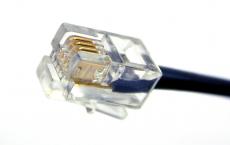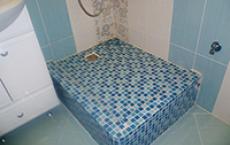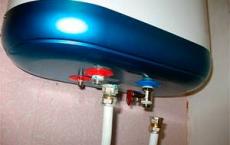What means can I wash the heating system. How to clean the heating system in a private house in stages
Washing the heating system in a private home is a delicate matter and not always grateful. Unfortunately, you did not specify in the explanation to the question - what elements does your heating system consist of (the material of pipes and radiators, what is the circulation of the coolant in the system, where is the boiler installed, filters are installed or not) - without such data it is difficult to answer your question specifically. It is necessary to set forth here only general recommendations on the washing of heating systems.
By itself, flushing the heating system is a compelling necessity, but only in central heating systems for multi-apartment, multi-storey residential buildings and it increases the efficiency of heating. Why is washing most effective only in central heating systems? This is a separate conversation - I will only say that the central heating system includes tens of kilometers of steel pipes, thousands of radiators, dozens of thermal units, heat points and control frames, as well as dozens of circulating pumps and heat exchangers for boilers and many more. . Moreover - in such huge, branched systems, there are often leakages of the coolant, and the boiler houses are forced to work on the "make-up" of the system with fresh tap water rich in oxygen. In such systems, many components are made of metal (mainly cast iron and steel). so these metals are oxidized when they are exposed to oxygen (and it is always contained in water) and high temperature, corrosion appears on the internal metallic surfaces of the heating system (on steel), black, oily deposits (on cast iron) - it is natural that the coolant carries these sediments throughout the system, and they settle in the narrowest places, thereby creating traffic jams.
That's to remove such traffic jams and wash the central heating system.
In individual houses - the picture is quite different, because there the length of the pipelines is small, and the system itself is much simpler and more compact than the central heating system. Consequently, the probability of the formation of plugs in such a system is rather low, especially if new modern materials and equipment (pipes, radiators, filters, etc.) are used in the heating system. And the question is whether washing of heating systems in such houses is so controversial. On the Internet, a lot of advice and advice on washing from people who are not entirely competent in this matter. Whether it is necessary to flush the heating system in a private house - it is up to the owner of the house to decide. After all, he only knows what components his heating system consists of, what is used as a coolant, how and how much the system works (whether there are non-heating), etc. The decision to wash, or not to wash, is taken in each particular case.
When there is no need to wash the heating system:
- If the heating system is new - it works less than 5 years.
- If there are no complaints about the operation of the system
- If the filter (grid) on the return at the end of the heating season is clean
- If the system uses pipes (PP) - polypropylene, or metal-plastic (in such pipes, the plaque is not formed)
- If the system does not have radiators made of cast iron or steel.
In all other cases - the system can also be washed for prophylaxis, but without fanaticism. Do not listen to "clever" recommenders to wash the system with chemical reagents (especially on the basis of acids). Chemical flushing can significantly shorten the life of the heating system. Wash with normal tap water at a pressure of 2 to 4 atm. (Pressure of the water supply system). The duration of the procedure is as long as there is no clean water coming from the return.
Flushing the heating system in an individual house by stages (one of the options):
- We drain the coolant from the system through the discharge valve in the return.
- We overlap the valves on the feed and return of the boiler (if they are installed) - to drive all the sludge through the boiler is not desirable.
3.Remove the expansion tank.
- We cut into the supply pipe a fitting with a valve at 15 at the end (according to the type of the vent valve on the return)
- We connect the flexible valve with the flexible hose with the valve on the water pipe.
- On the discharge fitting on the reverse we put on the rubber hose and fix it with a yoke. We drive the hose to the street, or to the sewer.
- We open the valve by 15 at the feed and the discharge valve on the return
- We open the valve on the water pipe and flush the system until the clean water flows from the return.
- Close the discharge valve, remove the plug from the expansion tank, we feed the system to the required level. Turn off the water supply tap to the system.
In especially severe cases, it is possible to add biological reagents (concentrate) to the heating system and drive the coolant through the system (including through the boiler, of course) within a day by a pump (if you have it installed), it is possible to pump the system - if the pump no. Then you need to drain the coolant with the reagent and rinse the system with clean water.
Silt and clogging of heating systems in private homes happen an order of magnitude more often than in apartment buildings. The consequence of contamination of pipelines and radiators is a drop in system efficiency, and even expensive repairs. In many ways, the owners themselves are to blame for this, since excessive savings in heating wiring, the use of cheap materials, neglect of such a procedure as flushing the heating system of an apartment house increases the likelihood of clogging.
Clogging of the system is expressed in the reduction of the capacity of pipes and radiators. Even with the use of forced circulation by the pump, the coolant moves more slowly, and the radiators installed further from the boiler warm with less force. There is an opinion that for 10 years of operation under unfavorable conditions, the capacity of pipes can drop to 50% of the original capacity. Of course, the cost of fuel proportionately increases, especially in systems with automatic temperature control in the house.
If in the apartment houses with centralized heating the cleaning measures are carried out by the corresponding communal services, then the owners of private houses must implement them themselves. Many problems can be avoided if a number of preventive measures are taken in advance to prevent pollution of the heating system.
Prevention.
If siltation - clogging with small particles of suspensions - all materials are equally exposed, then the deposit of mineral salts on the walls of the pipes is possible only in a number of cases. Here in the risk group metal structures, and cast iron to a lesser extent. And more - steel, made without anti-corrosion coating. It is enough to purchase pipelines with galvanizing, so that after half a century of operation inside they remain as new.![]()
With regard to the prevention of silting, there are fewer problems for owners of bimetallic and aluminum radiators. Unlike cast iron and panel steel, they have a small internal space for the coolant, water circulates in them at a higher speed, so the sediment simply does not have time to form.
Increases the likelihood of clogging of heating and open system design - in it the coolant often has to be refilled, and with new portions of liquid, salt and rubbish enter the pipes.
Now let's talk about how to flush the heating system in a private house. There are two different ways, comparable in their effectiveness:
- hydrochemical washing;
- hydropneumatic flushing.
Hydrochemical washing.
The technique consists in removing the coolant from the system and filling it with an aggressive medium, alkaline or acidic. Then a special pump is connected to the system, and the reagents circulate in the pipes up to 6 hours.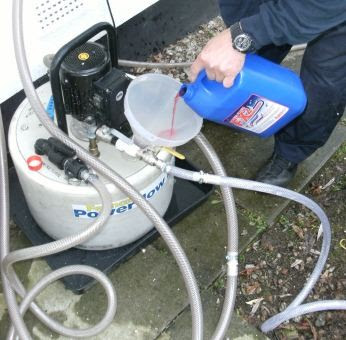
This method is not suitable for all systems. Due to the vulnerability of the material to corrosive substances, hydrochemical washing can not be used on aluminum pipes. Also, you should be careful with washing steel pipelines after 10 years of operation - internal corrosion and salt deposits will be removed, but this can open new leaks in the system. In addition, acid or alkaline reagents are quite expensive.
Hydropneumatic flushing.
An alternative way to clean the heating of a private house with your own hands is hydropneumatic, it's bubbling. It is especially often practiced in apartment buildings, but it is also effective for private houses. To carry out the cleaning you will need a special technique - installation-compressor.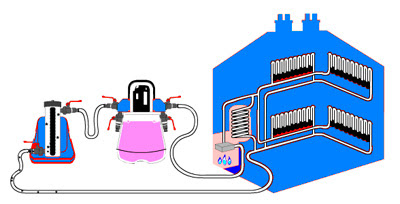
It is not necessary to remove the coolant from the system. The essence of the method is the simultaneous feeding of a mixture of water and air into the pipes at a pressure of 0.6 MPa. If the liquid will go constantly, then the air will be in portions with a large head. Due to this, turbulent turbulence is formed in the pipes, and silt and deposits are effectively knocked over.
It is desirable to connect the compressor at the lowest point of the pipeline, for example, to the drain and bay assembly. Under the water flow, one of the outputs at the upper point of the mains can be accommodated, for example, temporarily remove the expansion tank.
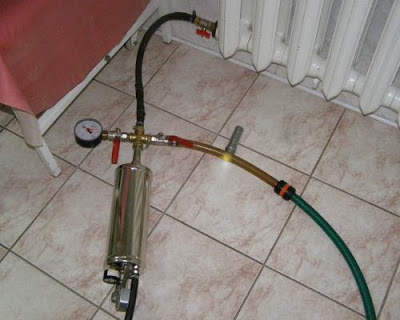
In the above-described hydropneumatic method, there is a variant - pneumohydraulic percussion. It has its own peculiarities - for the cleaning of pipes, a compressor is also needed, but it is capable of producing particularly strong kinetic impacts. The flow of air with an initial speed of 1.5 km / sec. forms a powerful wave that runs along the entire length of the pipes. But this method is effective only in systems where the mains have a maximum length of 60 m.
Than to wash out the heating system at home we told you. Do not underestimate the importance of this procedure. Regularly conducting it, you can not only extend the service life of heating, but also significantly save on fuel.
Content
Heating system is the most important part of engineering networks, uninterrupted operation of which provides comfortable living conditions in the cold season. Timely repairs, cleaning and other preventive measures significantly increase the service life, save fuel. If the management company is engaged in maintenance and repair in apartment buildings, all questions concerning how to flush the heating system in a private house must be solved independently.
Causes of clogging of the heating system
The most common cause of clogging in private house heating systems is the corrosion of the inner surface of pipes from exposure to air in a humid environment. After a while, fragments of rust, circulating along the pipes together with the coolant, settle and accumulate in the circuit. Particles settle in the most unfavorable areas - pipe turns, contributing to the appearance of ruptures and fistulas. Eventually, the heat carrier loses its capacity, there is a disturbance in the stability of the temperature regime at different sections of the pipeline, and therefore it is necessary to clean the system.
Another common and no less dangerous cause of clogging of pipes is scum. If corrosion is peculiar only to metal heating networks, the scale affects even the plastic pipes, clogging them with small particles. The quality filling the circuit, the water is significantly reduced, silt is formed, in which the garbage gets stuck.
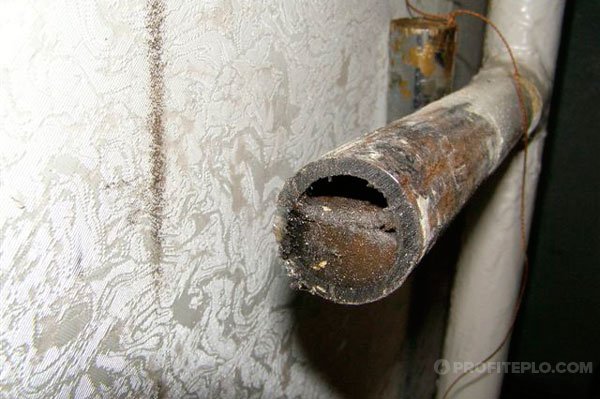 Contaminated heating pipes
Contaminated heating pipes Pipes made from any materials are equally exposed to pollution, therefore, irrespective of the type of pipeline, it is necessary to clean the system in a timely manner.
Why it is necessary to wash and with what frequency
In apartment houses connected to centralized heat supply networks, flushing of heating systems is carried out annually and strictly according to the schedule, corresponding to the requirements of SNiP. In the private sector, this procedure is carried out as necessary.
It will be much cheaper to clean up the system every year in a private house during the inter-heating period than to allow it to accumulate dirt and sediments in it for several years, waiting for the overlap of most of the pipeline cross-section.
In urban boiler plants, water treatment is regularly used to clean the coolant, but unsatisfactory condition of the networks leads to constant water pollution. With such a problem, municipal utilities are not easy to manage, because sometimes there are summer temporary outages of hot water.
Owners of the same individual housing fill the heating system with simple water from the water pipe without any preparation, in this case the only precaution is the installation of a filter at the input of water into the house. Regular and timely flushing of the heating system in the private house allows to increase the service life and improve the efficiency of the boiler, pipes and radiators, does not allow the formation and attachment of salt and scale to their walls, leading to destruction.
The filter installed in the boiler strapping scheme is able to protect the heating equipment only from small impurities originally present in the water and not causing any particular problems.
If the flushing of heating systems is not carried out for a long time, the resulting deposits are even more dangerous and lead to a significant reduction in the efficiency of the heating network, reducing the internal diameter of the pipes and, accordingly, the capacity. In this regard, the hydraulic resistance of the pipeline increases, and the batteries do not receive enough heat required for proper room heating. The scale in radiators and heat exchanger significantly reduces their heat transfer parameters. The heat generator has to consume more fuel to increase the energy of the coolant and, as a consequence, increase the temperature in the living room.
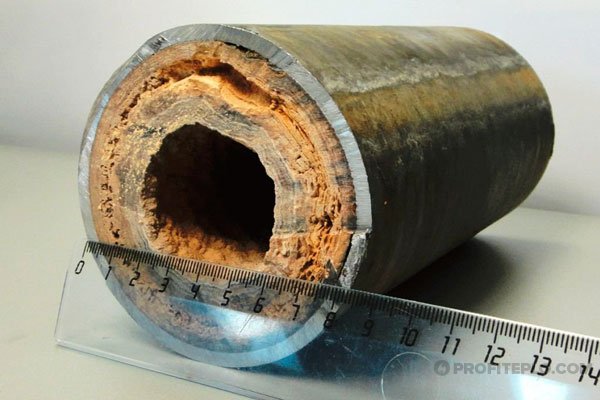 The resulting deposit in the pipe
The resulting deposit in the pipe Cleaning of the heating system is usually the last procedure in the queue, which is resorted to by the home owner concerned with the problem. Often, not understanding what the matter is, the owner raises the temperature of the coolant by simply turning the handle of the boiler, causing an increase in fuel consumption.
When identifying problems with the efficiency of heating, the system must be cleaned immediately. And in order to avoid such situations, arising as usual in the midst of the heating season, it is necessary to perform annual maintenance.
What and how to rinse the radiators and heating system
The process of cleaning the house heating system is not complicated, any master can cope with it.
There are several ways to clean the heating network in a private house with your own hands:
- mechanical flushing;
- dry cleaning;
- way pneumatic shock;
- biological washing.
Mechanical flushing
This way of washing the heating systems requires a complete disassembly of all communications - before you clean the elements, you have to remove every detail of the system. The complexity of the method is to clean the internal surfaces of pipes and batteries from scale and rust manually with metal brushes. In our time, almost not applied, because it requires a significant expenditure of time and effort.
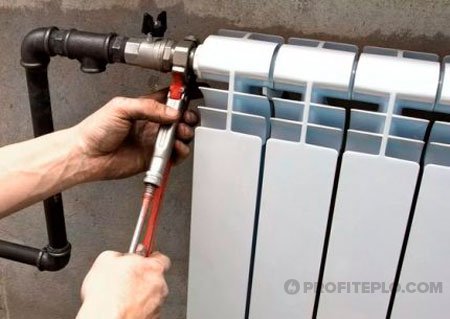 Dismantling for mechanical washing of the heating system
Dismantling for mechanical washing of the heating system Chemical washing method
To clean the system, it is necessary to connect a pump with a capacity filled with chemicals. The detergent dissolves and exfoliates the contaminants adhering to the pipe walls.
For chemical cleaning, two types of liquids are used: on acidic or alkaline basis, depending on the material from which pipes and batteries are made, as well as the type of deposits. Chemistry is recommended to flush the heating system also in those cases when it is too difficult to remove the elements of the system.
Liquids for washing based on alkali or acids can not be used when working with aluminum batteries due to the fact that the metal reacts with chemical compounds. It is also forbidden to perform purification of de-ice-cased systems, since the chemical detergent is toxic and can be harmful to health. For the same reason, used liquids can not be discharged into the sewage system, and work should be carried out in rubber gloves and a respirator.
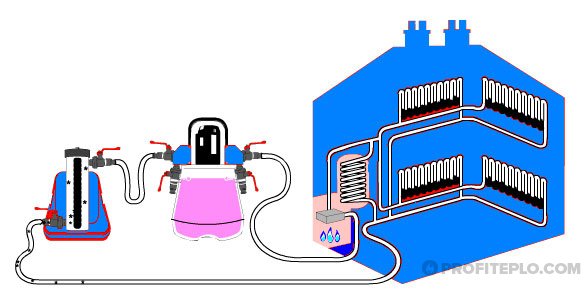 Chemical flushing
Chemical flushing Before flushing the heating pipes of an individual house, it will not be superfluous to have the help of an expert who will be able to select the optimal composition of the liquid on the basis of his own analysis of the contamination and the pipeline assembly.
After chemical cleaning all pollutants will be completely removed, the service life of the system will be extended.
Hydropneumatic flushing
This method consists in processing the internal surfaces of the batteries and pipes with a stream of high-pressure air-water mixture. Washing of the heating system in this way is highly efficient, but special equipment is needed to use it.
Hydropneumatic cleaning proved to be very effective when working with cast iron radiators of the old type, still Soviet-made. Cleaning with water and air does not impose any stringent requirements on the elements of the heating system, as a chemical method, that is equally suitable for all types of materials and pipes. Despite the high cost in comparison with the chemical method, it is completely safe and more efficient.
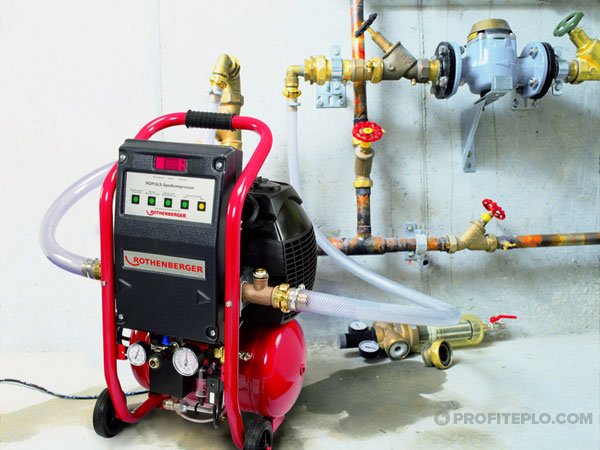 Connected equipment to the elevator for hydropneumatic washing
Connected equipment to the elevator for hydropneumatic washing Method of pneumatic shock
This method is the fastest (takes no more than an hour), it is convenient, since it is not necessary to dismantle the elements of the system, but requires the use of special techniques.
At the end of heating communications, special equipment is attached - a pneumatic gun, by means of which a pneumohydraulic impulse is applied to the pipeline, which exfoliates the contaminants adhering to the walls of pipes and batteries.
Despite the serious and intimidating name, the flushing of the pipes in this way is absolutely safe, since a force of no more than 2% of the pulse power is applied to the walls, and the main impact is contamination.
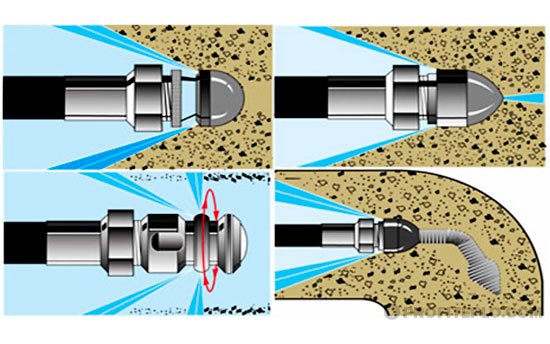 Principle of operation of air hammer
Principle of operation of air hammer It is possible to clean communication with air hammer only if their total length is not more than 50 m, otherwise the required efficiency will not be achieved.
Biological washes
At its core, this method is very similar to the chemical one, only high-tech solvents and wedging biologics are used instead of hazardous reagents. Under their influence, the crystalline bonds of pollutants are destroyed, corrosive and organic deposits are scraped off.
The washing biomaterial is produced on a water basis, and their use allows to completely clean the heating network in a multi-apartment building and in an individual dwelling.
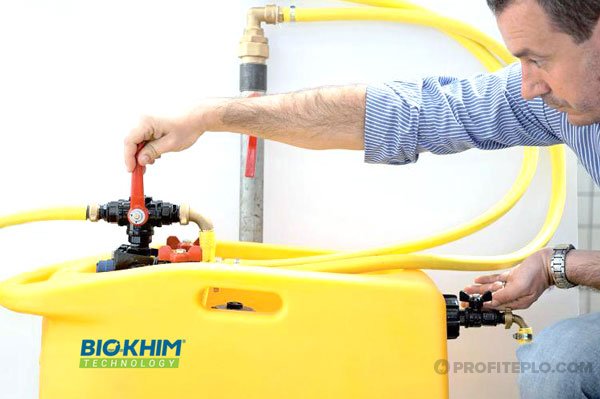 Process for cleaning pipes with washing biomaterial
Process for cleaning pipes with washing biomaterial Conclusion on the topic
Timely and regular cleaning allows to ensure uninterrupted and safe operation of home heating systems. When heating the house should not bring the matter to the adoption of radical measures - the use of chemistry or the use of air blasts, because carefully treat the system, from the boiler to radiators - much easier and cheaper.
After you wash the system, you should use special additives that reduce the corrosive activity of the metal. For these purposes, such a common substance as caustic soda is quite appropriate. As a result of preventive treatment with soda, you can significantly extend the life of the system.
1.
2.
3.
4.
5.
6.
The quality of the heat supply systems may deteriorate over time, probably most people had to face it in due time. Many people now have to live in houses erected at least twenty years ago.
It is in such buildings that a similar problem is most often encountered. Poor circulation of the coolant, whose role is most often performed by water, causes poor heating. The corrosion process degrades the quality of water, the impurities in which are deposited on the inner walls of pipes and radiators, preventing the normal passage of heat.
The way out of this situation, of course, is - or, for more "neglected" cases, its chemical purification (read also: ""). The photo clearly shows the difference between the pipes with a layer of deposits accumulated during the years of operation of the system without regular cleaning, and pipes that have been cleaned by one of the above methods.
A detailed description of such a problem, the reasons for its occurrence, and a description of the solutions we will consider in this article. Following the instructions below, you yourself will be able to find out how to clean the heating pipes and improve the quality of the heating system in your home or apartment.
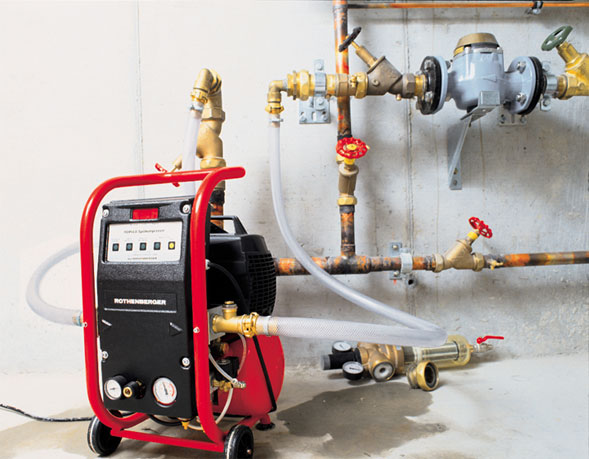
Why clean the heating system?
After cleaning the heating system, you will make its work more efficient, and heating your own home will become much better. The problem of contamination of heating equipment lies mainly in the improper quality of water.
Scum, gathering on the internal walls of pipes, radiators and other components of the heating system, is the reason:
- Accelerations of mechanical wear of pipelines and batteries
- Decreased heating efficiency.
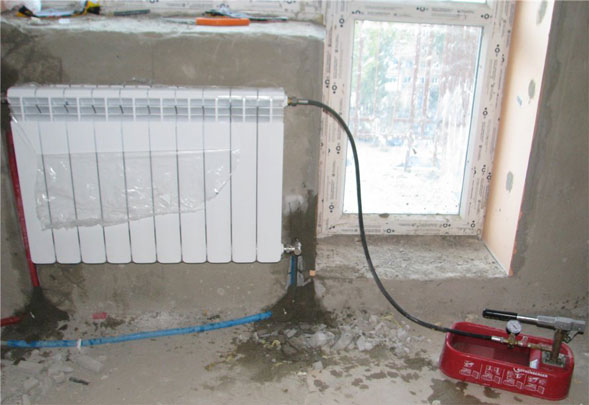
According to calculations of experts, the scum thickness of only one millimeter by fifteen percent reduces heat transfer. This significantly reduces the quality of the system and its economy. The throughput and heat transfer of the system are deteriorating. This result is due to a decrease in thermal resistance, a decrease caused by sediments.
Cleaning of the heating system - technology of work
The complex of works connected with the cleaning of the heating system consists of the following stages:- Primary diagnosis. As a result, the character of the formed scale and the composition of the deposits are determined.
- Selection of necessary.
- Drawing up of a technological map.
- Anticorrosion treatment is necessary to prevent the further formation of various deposits and scale. It follows the cleaning process.
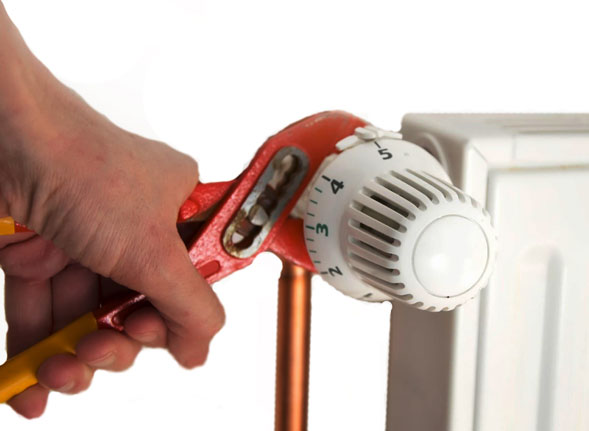
- The hydrodynamic
- Pneumohydropulse
- Chemical
Chemical cleaning of the heating system
According to experts, the latter type of cleaning is therefore so popular and in demand that, in comparison with other methods, it removes practically any deposits most quickly and qualitatively.
As a rule, aqueous solutions of organic and mineral acids, solvents, and alkalis are used as cleansing agents. Applying such a means for cleaning heating systems, it is necessary to be extremely careful and attentive, use eye protection and skin protection in work, since each of the solutions listed above is toxic.
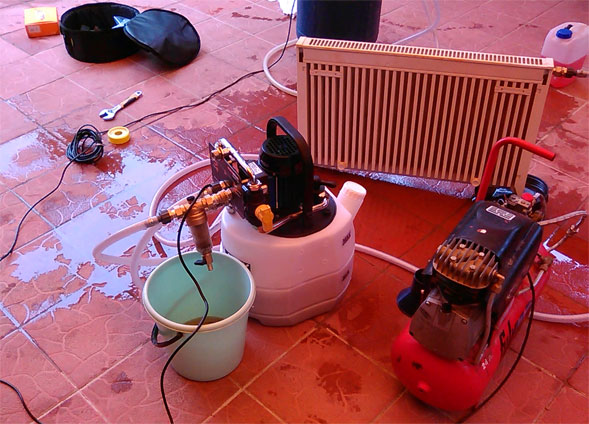
For systems equipped with aluminum radiators, these are not suitable, as they can break the integrity of the units.
For the work required special equipment:
- Pumps
- Hoses
- Capacities
- Powdered and liquid cleaning agents
Hydrodynamic cleaning of the heating system
Or - flushing the batteries. The necessary result is achieved here with the help of high-pressure water, destroying sediments and removing them from the system (more: ""). Special adapters and nozzles are used to connect the pipeline to external equipment that sends water to the system for cleaning.The disadvantage of this method can be considered higher, in comparison with the previous one, the cost of work, which is compensated by the safety of work and high quality of cleaning. For heating systems with cast-iron batteries, this method is the best, since radiators made of cast iron, more susceptible to contamination by sediments, are difficult to clean with chemical solutions.
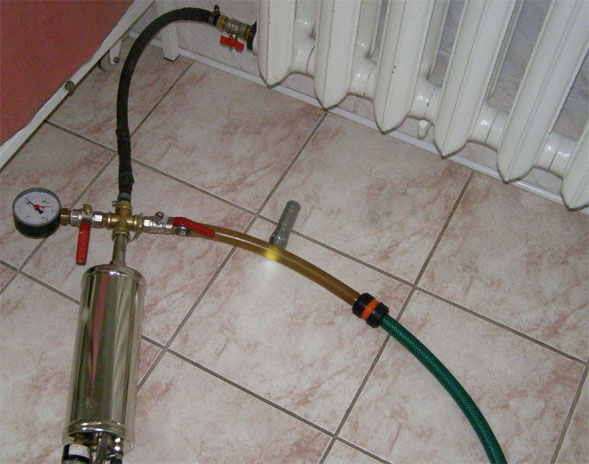
Pneumohydroimpulse cleaning of the heating system
It is the best way, if necessary, to clean the system without stopping its operation. A compact water pneumatic gun is capable of cleaning a pipeline section of up to fifteen centimeters. In addition, a connecting hose, "American" and adapters are required.Cleaning of heating boilers
The best solution in this situation will be the call of qualified specialists who will take all the work under their responsibility and perform all the necessary operations qualitatively.
Since it is necessary to clean the gas boiler regularly to ensure its reliable and high-quality work, owners of private households should have some idea about the technology, even if the work is done by specialists.
There are two most common cleaning methods:
- Rinsing of boilers with chemical reagents preheated to a certain temperature. The solution is pumped through the pump into the system and, reacting with the scum and destroying it, goes further along with the deposits to the outside (read also: "").
- Mechanical cleaning of the boilers is carried out with the help of brushes, scrapers and special mechanical devices. Before cleaning the gas boiler in a similar way from soot, it is necessary to fill the system with water, which should be brought to a boil, drained and then walked a metal brush over the contaminated surface.
Cleaning the heating system of a private house will allow its owners to extend the period of effective uninterrupted operation, reduce the cost of heating the mansion and prevent damage to heating equipment.
Flushing the heating system
Over time, even in regions with soft water, heating communications become clogged, which significantly reduces the heat transfer rate of heating systems. For 10 years of operation without cleaning pipes can lose 50% of their throughput, which will significantly reduce the efficiency of heating.
Over time, heating pipes and systems become clogged, this reduces the level of heat transfer.
1 mm of deposits, which are nothing more than ordinary scum, reduces the heating efficiency by 10-15%, and a 10 mm layer can reduce the heat return to 50-60%.
This means that it is necessary to flush the heating system. In private houses, where it is much easier to carry out than in multi-apartment buildings, it is recommended to flush the heating system annually.
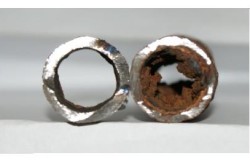
Pipes with deposits of silt, organic impurities, rust and scum deposited on the inner walls of pipes are recommended to be cleaned before each heating season.
Il, the presence of organic and inorganic impurities, the chemical reactions of impurities with the walls of communications, as well as rust and corrosion of pipes - all this is the cause of deposits on the inner surface of the pipes and, in particular, because of their complex structure, radiators. All these substances tend to settle on the walls of the pipeline and the elements of the heating system, forming a porous deposit, which is considerably inferior to the thermal conductivity of the metal, and therefore seriously reduces the efficiency of the system. In addition, poor heating performance damages the financial condition of the owner, as the efficiency falls, which entails a surplus of energy for sufficient heating of the premises.
Signs of pollution of the heating system
To know that it's time to rinse pipes and radiators from dirt, you can by the following signs:
- uneven heating of the radiator;
- the difference between the temperature of the radiator and the temperature of the pipes attached to it;
- after switching on the heating system is heated for a long time;
- the boiler makes extraneous sounds;
- increase in energy costs.
How do I flush the heating system?
To get rid of the sediment layer, the heating system can be cleaned. There are several ways to flush the heating systems, namely:
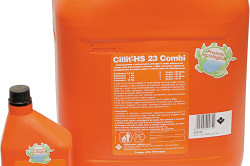
When washing chemically, a pump is connected to the batteries with a container, with chemical reagents that dissolve and peel the contaminants.
- Mechanical flushing. It is carried out by parsing communications and manually cleaning the internal surfaces of radiators and pipes from deposits by means of metal brushes. This method is practically not used, but can be used in private homes to clean the heating system by one's own hands.
- Chemical flushing. During the flushing process, the pump is connected to the system components with a container filled with chemical reagents, which dissolve and peel the impurities that have settled on the pipe surface. There are 2 types of washing liquids: acid and alkaline, used depending on the material from which the communications are made and the composition of the deposits.
It is forbidden to use both alkaline and acidic liquids for washing aluminum radiators, since aluminum reacts with chemicals and the radiator can be damaged. Do not use chemical cleaning of the heating system if the piping is not tight because the pipe cleaning fluids have a high level of toxicity and are harmful to health. For the same reason, the used liquid can not be discharged into the sewage system, and all cleaning works are allowed only in respirators and gloves. For flushing the pipes in this way, an expert will need help from an expert who will carry out water and pollution analysis and select the appropriate fluid appropriate to the situation and, importantly, the piping assembly so that the procedure does not damage the heating system equipment. As a result of the treatment with chemicals, all the impurities are removed completely, allowing as a result to operate your heating system for about 20 years until the next washing session.
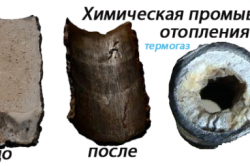
- Hydropneumatic washing consists in the treatment of the internal surface of pipes and radiators of the heating system by jets of water and air supplied at high pressure. To implement this method of cleaning requires special equipment, and the result will be a complete cleaning system. This method is very well proven when cleaning old cast iron radiators. It does not impose special requirements on heating equipment, in contrast to the chemical method, that is, it is suitable for all types of pipes and materials. It is effective and safe, although somewhat more expensive than the chemical method. When cleaning the radiators, they must first be handed over to the service for treatment of the pollution-softening composition, and then proceed to hydropneumatic treatment. The result of this method will be a complete cleansing of the communications from the deposits.
- The method of pneumatic shock is quite fast (up to 1 hour of work), it is convenient, since it does not require the dismantling of the heating system, but, like the rest of the methods, requires the use of special equipment. To the ends of the heating communications a special pneumatic gun is attached, which pumps a pneumohydraulic impulse into the pipeline, which destroys the contamination that has settled on the walls of the heating equipment. Despite the frightening name, this method is safe, since a force equal to 2% of the total pulse power acts on the walls, and the rest is impacted by deposits. This method has its limitations. The length of all cleared communications should not exceed 50-60 m, since such a distance is the maximum for effective operation of this method.
- Biological washes. On the implementation of cleaning this method is similar to chemical, but instead of toxic substances using high-tech wedging and dissolving substances. They dissolve fats and destroy crystalline structures, purify corrosive formations and organic deposits. Are made on a water basis, and their use completely remove plaque and clears the heating equipment.
After cleaning the heating system or during cleaning procedures, it is possible to use special additives that reduce the reactivity of the metal of communication facilities, which reduces the amount of subsequent deposits. As a result of this prophylaxis the service life of the water pipe is significantly increased.
How do I flush the heating system myself?
It makes sense to clear heating communications in private houses with your own hands, since the distance of the pipeline is relatively small, and your neighbors will not cause any inconvenience to your neighbors. If you want to avoid the cost of buying or renting cleaning equipment, then you will only need a manual cleaning method.
Mechanical flushing
To do this, you need:
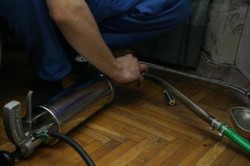
The method of pneumatic shock is safe and very effective.
- iron brush;
- a metal rod;
- capacity for the radiator (an ordinary bathtub is suitable);
- water source;
- hose for water supply.
Instructions for mechanical cleaning:
- Everything begins with the drainage of water from the heating system.
- It is necessary to dismantle radiators and those parts of the water pipe, which must be cleaned.
- Put the radiator in the container. If it is a bath, then it is worthwhile to lay it with several layers of fabric to protect it from damage.
- Next, you need to clean the inside of the radiator and clean them with a brush and, if necessary, a metal rod, until the descaling pieces stop leaving, and the water will remain clean.
- Mounted radiator is usually the opposite, that is, the top part down.
Washing with the use of special means
If you have at your disposal pipe cleaning equipment, then you can clean the heating system more efficiently. The best methods for a private heating system are the hydro-pneumatic and biological methods. Recall that for the effective operation of the pneumohydraulic method of cleaning, the length of the cleared communications should not exceed 50-60 m.
List of tools:
- A pump (also called a "booster") and a cleaning fluid or a pneumatic hydrospun.
Washing instructions:
- At the inputs and outputs of the heating system, the pump or gun nozzles are worn. The boiler must be switched off.
- Depending on the method, either a pump or a gun is used.
- The cleaning agent is filled into the pump tank, after which the access to the heating system is opened and the booster is turned on. Water mixes with the cleaning agent and circulates through the system, dissolving the deposits. After 2 hours, the pump can be disconnected from the heating system and drained.
- The gun is opened to the heating system and produces the required number of "shots". The waste water must also be drained.
- The heating system is filled with fresh water and connected to the boiler.
Regularly flush the heating system in your home. This way you can save your own money without paying for inefficient operation of your heating equipment.

